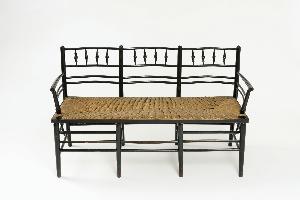Philip Speakman Webb
Philip Speakman Webb;Philip Webb
Place: Witley
Born: 1831
Death: 1915
Biography:
Philip Speakman Webb was a British architect and designer, born on January 12, 1831, in Oxford, England. He is often referred to as the Father of Arts and Crafts Architecture due to his significant contributions to the movement. Webb's use of vernacular architecture demonstrated his commitment to "the art of common building." His designs were characterized by simplicity, functionality, and a focus on craftsmanship.
Early Career and Influences
Webb began his career as an architect in the 1850s, working under the guidance of George Edmund Street. During this time, he met William Morris, with whom he would later collaborate on several projects. The two men shared a passion for medieval architecture and the Arts and Crafts movement. Webb's early work was influenced by the Gothic Revival style, but he soon developed his own unique approach to design.
Notable Works
Some of Webb's most notable works include Red House, designed for William Morris in 1859. This house, located in Bexleyheath, Kent, is considered one of the first examples of Arts and Crafts architecture. Other notable works by Webb include Buffet, a stunning example of his attention to detail and commitment to beauty. Webb's designs were not limited to houses; he also created furniture, metalwork, and other decorative pieces. His work can be found in various museums, including the Musée d'Orsay in Paris and the Victoria and Albert Museum in London.
Collaborations and Legacy
Webb collaborated with several prominent artists of his time, including William Morris, Edward Burne-Jones, and Dante Gabriel Rossetti. He was also a founding partner of Morris, Marshall, Faulkner & Co., a furnishing and decorating firm. Webb's legacy extends beyond his own work; he paved the way for future generations of architects and designers.
- Webb's use of vernacular architecture influenced the development of the Arts and Crafts movement.
- His designs emphasized simplicity, functionality, and craftsmanship.
- Webb collaborated with prominent artists of his time, including William Morris and Edward Burne-Jones.
of Webb's work include his attention to detail, commitment to beauty, and emphasis on community. His designs continue to inspire architects and designers today. For more information on Philip Speakman Webb and his work, visit Wikioo.org or Wikipedia. You can also explore the William Morris Gallery and Musée d'Orsay collections on Wikioo.org.



